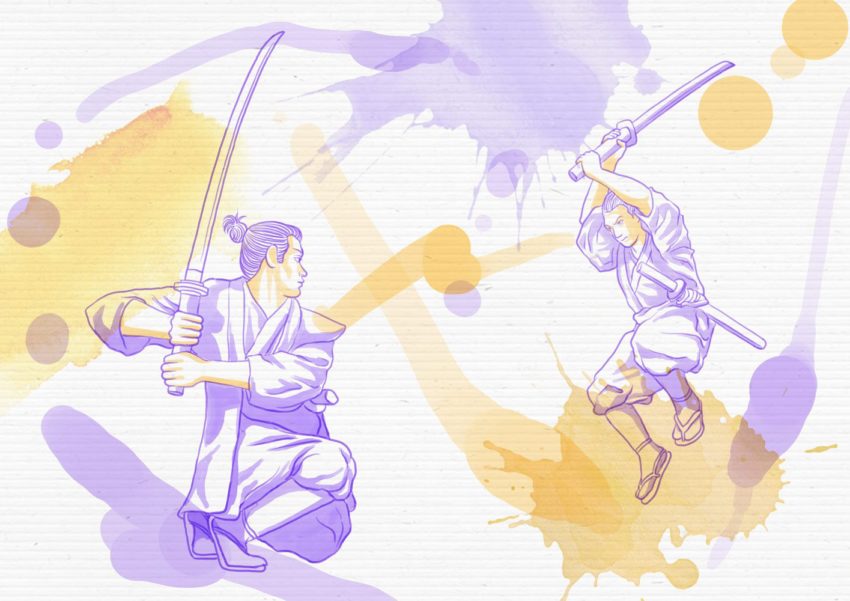Samurai. The very name immediately conjures up images in your mind of honor, fierceness, and warfare. You may see the samuraiSAMURAI 侍 "warrior serving a lord" learn more... kneeling in meditation in his robes, his topknot perfectly aligned. You may see him standing, dressed in his armor, surveying the battlefield and ready to do his duty. But one thing is for certain… in either circumstance, you are most likely seeing samurai warriors with Japanese samurai swords at their sides.
The Importance of Japanese Samurai Swords
Throughout the history of the samurai, nothing was more a symbol of his warrior’s code – bushidoBUSHIDO 武士道 "way of the warrior" learn more... – than his sword. Japanese samurai swords were considered so important that one was brought into the bedchamber before the birth of a warrior’s new child. And when it came time for an older samurai to die, his sword would be brought to him and placed at his side.
Not only an exquisite masterpiece of function and form, a samurai’s sword was considered a part of his soul and would be passed down in his family generation after generation. If the hilt or scabbard wore out or was broken, a new one would be commissioned immediately. While the most iconic of all Japanese samurai swords is the katanaKATANA 刀 "sword" learn more..., it is not the first sword to be in the service of the samurai.
Tachi: Soul of a Samurai
According to legend, the tachiTACHI 太刀 "great sword" learn more... sword was invented around 700 A.D. in Yamato Province after a swordsmith named Amakuni noticed that nearly half of the warriors returning from battle would come back with broken blades. As you can imagine, a great swordsmith like Amakuni couldn’t just stand idly by, so he began redesigning the sword. His blades began to take on the distinctive single edge and curved blade you associate with samurai today.
A tachi is a very long sword with the average blade length being around 31 inches, with a single edge and a curved middle section – quite a thing to imagine facing down in the heat of battle! The tachi was so long, in fact, that it was heavily favored by the cavalry as its length and blade curvature made it easy to slice down unfortunate enemies as the samurai rode past them at full gallop.
Despite its length, the tachi was light enough that it could be wielded easily with only one hand, which made for a definite advantage while mounted on horseback. It also featured a specially designed hilt that was long enough to grip with two hands, so its killing prowess was also an advantage while fighting on foot. Interestingly, the primary strategy of fighting with the tachi was to turn the sword to its blunt edge when making contact with the opponent’s blade. The sharpened edge was employed when it was time to finally dispatch the poor soul.
Over time, as the katana began to take its place on the battlefield, the tachi evolved into a ceremonial sword for court rituals. At this point, the tachi was very highly decorated with traditional cord wrappings and elaborately-carved scabbards, sometimes fashioned from ivory. If a samurai was going to court, he was going dressed to impress.
Katana Means “Sword”
Few things can instantly evoke the feeling of an entire culture and time like the Japanese katana. It is universally seen as the ultimate symbol of Japanese samurai swords, the single most iconic representation of the samurai way of life and their ability to deal out death at will with an ironclad resolve. When you see a katana, there is no mistaking who it was made for and what its purpose was: to unleash a samurai’s fury upon his enemies. It even made Tom Cruise look almost intimidating!
Japanese samurai swords of the katana variety began appearing after the tachi, generally around 1400 AD, and followed the natural evolution of Amakuni’s tachi design while shortening the blade. The katana’s blade is 24-27 inches long with a full length curve that made for quick and efficient body slices. Heavily favored by nearly all samurai and often named by them, the katana normally featured a richly engraved hand guard (tsubaTSUBA 鍔 "sword's hand guard" learn more...) along with a two-handed hilt.
Katana were considered excellent for close-quarters combat as the shorter blade made it easier to quickly draw the sword and strike the enemy in one fluid motion. It was also amazingly light with the blade featuring the so-called “blood groove” or fuller, which actually served to make the sword lighter without reducing the strength of the blade. This feature allowed a samurai to fight for an extended period of time without becoming overburdened by the weight of his weapon, as he terrified his enemies with a succession of highly-practiced strikes.
While all swords used by the samurai were created with great care, the creation of a katana blade was considered almost a religious ceremony. The swordsmith would undergo a spiritual purification and Shinto priests would be brought in to bless the beginning of a new katana’s formation. The swordsmith was said to “commit his soul and spirit into the forging and tempering of the steel.”
Katana blades feature a four bar technique to achieve their legendary prowess – a soft iron bar to prevent breaking, two hard iron bars to prevent bending, and a single steel bar to take the deadly razor sharp edge you envision when you think of samurai fighting. Layered and heated together before being hammered into one nearly indestructible blade, this process would produce the hamonHAMON 刃文 "blade pattern" learn more... or “wavy line” that is used to judge the swordsmith’s skill at creating his art.
The blade of a newly formed katana would be tested by a master swordsman by slicing through a stack of dead bodies or some poor criminal who drew a short stick. Unfortunately, Japan was also a feudal society, it was also also not uncommon samurai to test their new blades on whatever hapless commoner crossed their path in the street, which was considered completely legal. Ouch.
Creating completed Japanese samurai swords involved fashioning all the various pieces, including the hilt, the hand guard, the scabbard, etc. The entire process could take a team of 15 different craftsman and artisans up to six months to finish. Small wonder katana were so highly prized by samurai and are so highly sought after by collectors today.
Wakizashi: Making Heads Roll
The wakizashiWAKIZASHI 脇差 or 脇指 "medium-length sword" learn more... was the second, shorter sword a samurai would wear and was considered closer to a samurai’s soul than even the katana. Contrary to the movies, wakizashi were in fact the Japanese samurai swords used to behead a defeated enemy after battle. They were also the Japanese suicide sword normally chosen to perform seppukuSEPPUKU 切腹 "cutting the stomach" learn more..., or ritual suicide, by a samurai wishing to keep or reclaim his honor. Wakizashi were nearly inseparable from their masters. While tradition dictates that samurai would surrender their katana when entering a house or castle, his wakizashi could be worn anywhere at all times. He would even bring it to his bedroom to ensure he had a weapon readily available should he need it.
Wakizashi blades vary in length from 12-20 inches with a slightly curved blade and a square-shaped handle. Due to its shorter length, it was an excellent sword for fighting in close quarters, particularly indoors when the need arose. It was largely used to make dangerous cuts to the weak part of the body and allow your foe to simply bleed to death.
Wakizashi were utilized widely across Japanese society, including by travelers and merchants due to their efficiency as well as widespread availability. However, wearing a wakizashi with a katana was called daishoDAISHO 大小 "big and small" learn more... – literally “big and small” – and was reserved only for samurai. Non-samurai caught wearing this combination would be killed on sight. Later samurai also trained in the art of fighting with katana in one hand and wakizashi in the other, which is known as nitoken. This was made famous by Miyamoto Musashi, who was said to never have been defeated using this style.
It’s Tanto, Not Tonto
The third sword a samurai would wear was called a tanto, which is actually a dagger rather than a true sword as you know it. TantoTANTO 短刀 "short sword" learn more... blades generally ranged from 4 inches to 10 inches in length and could be either single-sided or double-sided. Tanto came both with and without a hand guard and normally featured simple wooden hilts. Regardless of their smaller size, tanto were still a useful backup for a samurai to have and actually were paired with tachi to form the first daisho pairings.
Back to the Future
Nowadays, traditional Japanese samurai swords are still made – occasionally in other locations, though the vast majority are produced in Japan. These swords are called shinken, which means “true sword.” They are made by traditional techniques using traditional materials. These swords are collectibles and can be expensive due to their high quality and ties to traditional swordsmithing.
As with anything else in life, there are also a large number of lower grade swords available that were not made using the intensive smithing techniques of ancient Japan. These swords tend to be highly decorative and feature fancy designs since they are largely just for show. Most collectors these days are happy to have these in their grasp, since they are usually more affordable and often gorgeous examples of art in their own right.
Then there is the bustling market for authentic antique swords. Their quality ranges but many are generally in good repair and may feature the swordsmith’s name on the blade. These may be a bit pricey at times, but the cost is offset by knowing you own an amazing piece of Japanese history, a weapon worn and wielded by a master warrior whose legacy even time can not defeat.

